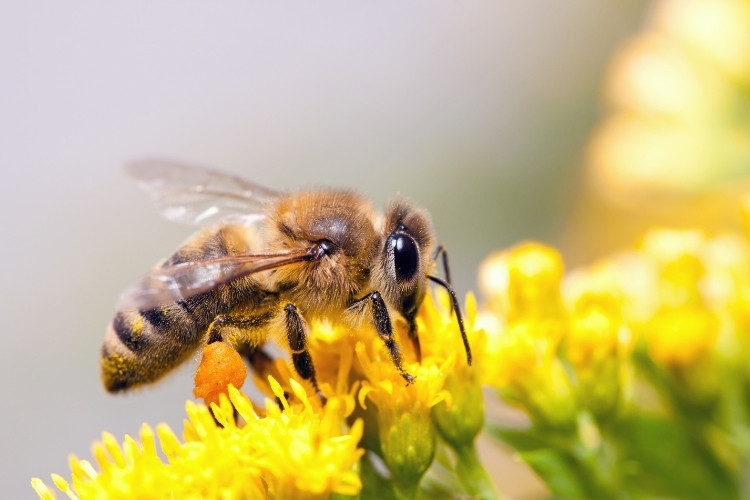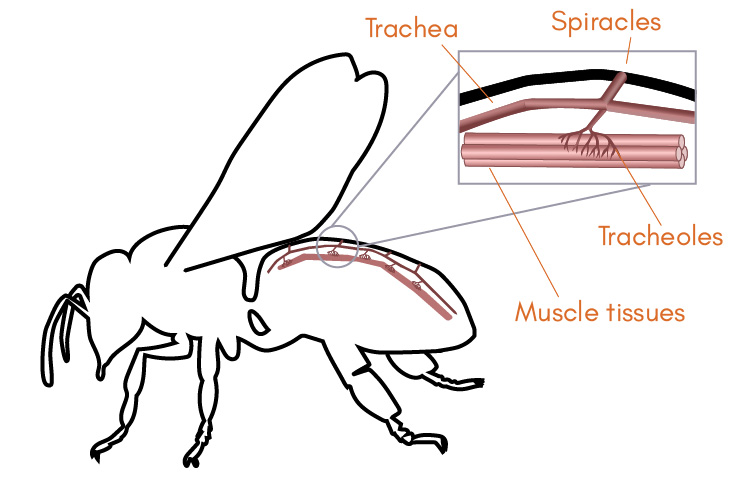Lungs are essential for human beings. Our lungs take the oxygen we breathe and transfer it to the bloodstream, which in turn carries it around to the other parts of our bodies.
But not all living things breathe in the same way we do. In fact, many creatures have developed quite different methods of breathing to best suit their natural habitat.
So what about honey bees – how do they breathe? Do they have lungs? Or do they use a different system to take oxygen into their bodies?
Bees do need oxygen to survive, and they also dispel carbon dioxide from their bodies to avoid oxidative damage to their tissues just like humans. However their respiratory system is quite different from our own.

Bees Don’t Have Lungs Like Humans
As humans, our respiratory system is connected with our circulatory system – this enables the lungs to pass oxygen to the bloodstream and carry it to the other cells in our bodies. Bees, on the other hand, have a respiratory system that does all the work itself.
Bees do not have lungs in their respiratory system. Instead, air enters through small holes on their bodies called spiracles. Those holes lead to a network of strong, flexible tubes called trachea.
The trachea are connected to a series of much smaller tubes known as tracheoles. The tracheoles connect directly to the cellular tissues inside the bee that require oxygen.
The closest thing to lungs inside a bee’s respiratory system are air sacs located inside the trachea. These sacs expand and contract depending on the bee’s need for oxygen, helping to control the amount of air that flows down through the tubes.

Spiracles – openings on the outside of a bee’s body which breathe in air.
Trachea – small tubes connected to the spiracles along which the air travels.
Tracheoles – tiny tubes located at the end of the trachea which connect to the cellular tissues.
Air sacs – located inside the trachea, they expand and contract to control the flow of oxygen.
So Then… How Do Bees Breathe?
Bees breathe by taking in air through the spiracles located along their bodies. The air travels into the spiracles (holes), down through the trachea (tubes) to reach the tracheoles (smaller tubes).
Once the air reaches the tracheoles, an exchange of gasses takes place. Oxygen diffuses directly into the tissues, while the carbon dioxide diffuses from the tissues, before it travels back up the trachea and is expelled into the atmosphere.
As mentioned above, air sacs located inside the trachea play an essential role in helping bees breathe. They expand to suck in oxygen, then contract to push it to where it needs to go – much like lungs do for us humans.
Interestingly, these sacs are controlled by muscle movements in the abdomen. Bees contract their abdomens in a movement not too dissimilar to an accordion to help them breathe.
If you see a bee contracting its abdomen more vigorously than usual, it’s probably because they either need more oxygen, or have too much carbon dioxide. It’s a bit like when you or I might take a few deep breathes after exercise.
Can Bees Breathe Underwater?
Bees cannot breathe underwater. However, if they do become submerged, or get cut off from oxygen another way, they can survive for a short period of time because of the way their respiratory system works.
You see, the air sacs located inside a bee’s trachea have the ability to hold onto air and release it as needed. When underwater, bees can close their spiracles and breathe using the oxygen stored inside these sacs, rather than needing to take in new air from outside.
However, bees cannot survive underwater for very long because they cannot breathe when submerged – nor can they swim. To breathe when submerged, bees would need a way of extracting oxygen from water, which is something they are incapable of (unlike fish, which do this using their gills). With their spiracles closed, bees need to resurface to access air.
As an interesting side note, many other insects use a similar technique to bees to survive challenging environments. For example, insects that live in a desert can close their spiracles to stop moisture from evaporating, and use the air sacs as a kind of oxygen reservoir to continue passing oxygen into their tissues.
Summing Up…
Like human beings, honey bees need oxygen to survive – they just breathe it into their bodies in a different way.
Bees breathe through holes located along their body (called spiracles). Each hole is connected to a tube (trachea).
The expansion and contracting of small air sacs inside these tubes pushes the air down through smaller tubes (tracheoles) until it reaches the individual cells that need oxygen. Carbon dioxide is also diffused before it travels back up the tubes and out through the holes into the atmosphere.
